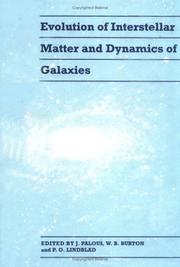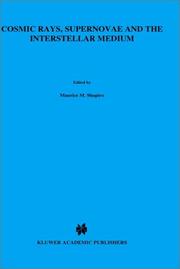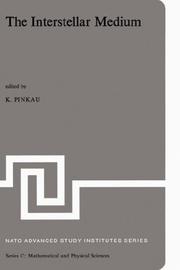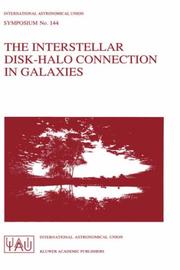| Listing 1 - 8 of 8 |
Sort by
|

ISBN: 0521419840 Year: 1992 Volume: vol 1 Publisher: Cambridge, UK : Cambridge university press,
Abstract | Keywords | Export | Availability | Bookmark
 Loading...
Loading...Choose an application
- Reference Manager
- EndNote
- RefWorks (Direct export to RefWorks)
Galaxies --- Interstellar matter --- Molecular clouds --- Congresses. --- Congresses --- Galaxies - Congresses. --- Interstellar matter - Congresses. --- Molecular clouds - Congresses.
Book
ISBN: 0471238759 9780471238751 Year: 1972 Volume: 21 Publisher: London ; New York, NY : Wiley-Interscience,
Abstract | Keywords | Export | Availability | Bookmark
 Loading...
Loading...Choose an application
- Reference Manager
- EndNote
- RefWorks (Direct export to RefWorks)
Plasma (Ionized gases) --- Interstellar matter --- Congresses --- Solar system --- Congresses. --- Plasma (Ionized gases) - Congresses --- Interstellar matter - Congresses --- Solar system - Congresses

ISBN: 0792312783 9780792312789 Year: 1991 Publisher: Dordrecht: Kluwer,
Abstract | Keywords | Export | Availability | Bookmark
 Loading...
Loading...Choose an application
- Reference Manager
- EndNote
- RefWorks (Direct export to RefWorks)
Cosmic rays - Congresses. --- Galactic cosmic rays - Congresses. --- Supernovae - Congresses. --- Interstellar matter - Congresses. --- Astrophysics - Congresses. --- Cosmic rays --- Galactic cosmic rays --- Supernovae --- Interstellar matter --- Astrophysics

ISBN: 9027704171 940102152X 9401021503 9789027704177 Year: 1974 Volume: 6 Publisher: Dordrecht ; Boston, MA : D. Reidel,
Abstract | Keywords | Export | Availability | Bookmark
 Loading...
Loading...Choose an application
- Reference Manager
- EndNote
- RefWorks (Direct export to RefWorks)
Interstellar matter --- Congresses --- 524.5 --- -#KVIV --- #WSTE:STER --- Interstellar medium --- Astrophysics --- Matter --- Space environment --- Interstellar reddening --- Interstellar medium. Galactic nebulae --- Congresses. --- 524.5 Interstellar medium. Galactic nebulae --- #KVIV --- Interstellar matter - Congresses

ISBN: 052135580X 9780521355803 Year: 1988 Publisher: Cambridge Cambridge University Press
Abstract | Keywords | Export | Availability | Bookmark
 Loading...
Loading...Choose an application
- Reference Manager
- EndNote
- RefWorks (Direct export to RefWorks)
Cosmic dust --- Astronomical spectroscopy --- Interstellar matter --- Congresses --- 524.5 --- -Astronomical spectroscopy --- -Interstellar matter --- -Interstellar medium --- Astrophysics --- Matter --- Space environment --- Interstellar reddening --- Spectroscopy, Astronomical --- Absorption spectra --- Spectrum analysis --- Dust --- Interstellar medium. Galactic nebulae --- -Interstellar medium. Galactic nebulae --- 524.5 Interstellar medium. Galactic nebulae --- -Astrophysics --- Interstellar medium --- -524.5 Interstellar medium. Galactic nebulae --- Cosmic dust - Congresses --- Astronomical spectroscopy - Congresses --- Interstellar matter - Congresses

ISBN: 0792354745 9401060185 9401148066 9780792354741 Year: 1999 Volume: 523 Publisher: Dordrecht: Kluwer academic publishers,
Abstract | Keywords | Export | Availability | Bookmark
 Loading...
Loading...Choose an application
- Reference Manager
- EndNote
- RefWorks (Direct export to RefWorks)
Interstellar dust, meteorites, interplanetary dust particles (IDP's), the zodiacal light, comets, comet dust. Where do they come from, what are they made of, how do they evolve, and finally, are there connections between them? These are the questions discussed in this volume by some of the world's outstanding experts in their respective fields. The techniques used for studying the `small' solid objects of space are thoroughly discussed. Some of the methods involve a synthetic approach using the laboratory to create analog environments and materials which are believed to resemble those in space. Others use direct laboratory methods with state-of-the-art analytical tools to study the material of the objects themselves - meteorites, IDP'S. And others apply the latest in astronomical facilities to provide quantitative data on the material properties of the solids which can only be deduced from remote observations, These are compared with the laboratory results. In one instance there was a possibility to study a solar system body in situ and that was the case of comet Halley and some of the results of these studies obtained from space `laboratories' launched to meet it are discussed here. Finally, there are theoretical papers which are aimed at bridging the results of observational and laboratory methods. This book is recommended to senior scientists as well as graduate students who wish to pursue research in interstellar and solar system astronomy and their connections.
Astrophysics --- Solids --- Cosmochemistry --- Interstellar matter --- Cosmic dust --- Congresses. --- Observations, Astronomical. --- Astronomy—Observations. --- Astrophysics. --- Physical chemistry. --- Organic chemistry. --- Astronomy, Observations and Techniques. --- Astrophysics and Astroparticles. --- Physical Chemistry. --- Organic Chemistry. --- Organic chemistry --- Chemistry --- Astronomical observations --- Observations, Astronomical --- Chemistry, Theoretical --- Physical chemistry --- Theoretical chemistry --- Astronomical physics --- Astronomy --- Cosmic physics --- Physics --- Astrophysics - Congresses. --- Solids - Congresses. --- Cosmochemistry - Congresses. --- Interstellar matter - Congresses --- Cosmic dust - Congresses.

ISBN: 0792312554 Year: 1991 Volume: vol 144 Publisher: Dordrecht Kluwer
Abstract | Keywords | Export | Availability | Bookmark
 Loading...
Loading...Choose an application
- Reference Manager
- EndNote
- RefWorks (Direct export to RefWorks)
52 <063> --- Disks (Astrophysics) --- -Galactic halos --- -Galaxies --- -Interstellar matter --- -Interstellar medium --- Astrophysics --- Matter --- Space environment --- Interstellar reddening --- Extragalactic nebulae --- Nebulae, Extragalactic --- Astronomy --- Halos, Galactic --- Astronomie. Astrofysica. Ruimteonderzoek. Geodesie--Congressen --- Congresses --- Milky Way --- -Galaxy (Milky Way) --- Local Group (Astronomy) --- Galactic halos --- Galaxies --- Interstellar matter --- Congresses. --- -Astronomie. Astrofysica. Ruimteonderzoek. Geodesie--Congressen --- -Congresses --- Galaxy (Milky Way) --- Galaxies - Congresses. --- Milky Way - Congresses. --- Disks (Astrophysics) - Congresses. --- Galactic halos - Congresses. --- Interstellar matter - Congresses.
Book
ISBN: 9781402069338 1402069324 9781402069321 9048177693 9786612235825 1282235826 1402069332 Year: 2008 Publisher: Dordrecht : Springer,
Abstract | Keywords | Export | Availability | Bookmark
 Loading...
Loading...Choose an application
- Reference Manager
- EndNote
- RefWorks (Direct export to RefWorks)
Studies of Nearby Galaxies are currently the focus of many observations and numerical simulations. This book presents an overview of the galaxies within the Local Volume (D < 10 Mpc), including the Local Group (D < 1 Mpc) and our closest neighbours, the Andromeda Galaxy and the Magellanic Clouds. Presented are the latest results from radio, infrared and optical surveys as well as detailed multi-wavelength studies of individual galaxies. Accurate distances are now available for the majority of Local Volume galaxies providing a true 3-dimensional view of their distribution and flow pattern as well as their star formation.
Physics. --- Astronomy, Astrophysics and Cosmology. --- Astronomy. --- Astrophysics. --- Physique --- Astronomie --- Astrophysique --- Andromeda Galaxy -- Congresses. --- Interstellar matter -- Congresses. --- Local Group (Astronomy) -- Congresses. --- Triangulum Galaxy -- Congresses. --- Astronomy & Astrophysics --- Physical Sciences & Mathematics --- Astrophysics --- Galaxies --- Local Group (Astronomy) --- Local Group of galaxies --- Cosmology. --- Observations, Astronomical. --- Astronomy --- Space sciences. --- Astrophysics and Astroparticles. --- Extraterrestrial Physics, Space Sciences. --- Astronomy, Observations and Techniques. --- Observations. --- Space Sciences (including Extraterrestrial Physics, Space Exploration and Astronautics). --- Astronomical physics --- Cosmic physics --- Physics --- Astronomy—Observations. --- Astronomical observations --- Observations, Astronomical --- Science and space --- Space research --- Cosmology --- Science
| Listing 1 - 8 of 8 |
Sort by
|

 Search
Search Feedback
Feedback About UniCat
About UniCat  Help
Help News
News